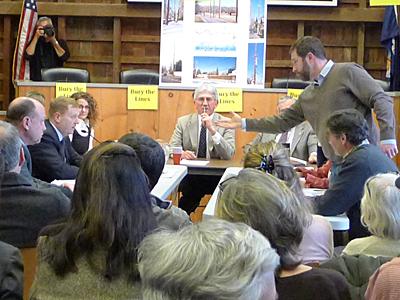PSEG Project Will Go On, Utility Official Says

The president and chief operating officer of PSEG Long Island, David M. Daly, agreed at a heavily attended meeting at East Hampton Town Hall on Wednesday to take a second look at alternatives to a six-mile extension of high-voltage electrical transmission lines, strung from poles up to 65 feet tall that, appalled residents have said, have destroyed the traditional, bucolic look of town and village streets.
Mr. Daly agreed to meet again as soon as Friday with East Hampton Town Supervisor Larry Cantwell, East Hampton Village Mayor Paul F. Rickenbach Jr., and other members of a working group to draft a plan for the reconsideration of options originally thought to be not viable, such as burying the lines along the Long Island Rail Road right of way or along Montauk Highway.
He refused, however, to suspend work for the rest of the week by crews installing the poles at a rapid rate.
"Give us Thursday and Friday," Jeremy Samuelson, a member of a participating citizens' panel asked him, rising from his seat and reaching across the table for a handshake. "You're asking for our trust," Mr. Samuelson said. Mr. Daly remained seated.
Mr. Daly promised that the options, their costs, and possible funding sources would be examined seriously.
The group to be involved will include members of Save East Hampton: Safe Responsible Energy, which presented a petition at the meeting Wednesday calling for removal of the poles and burial of the transmission lines that was signed by 2,000 people.
Mr. Cantwell pressed Mr. Daly to return on Friday willing to make a commitment to bury the power lines. "Two days . . . certainly would have been a good gesture," he said. "What's more important, I think to me at this point, is a commitment that we will bury."
Mayor Rickenbach twice expressed a similar hope. "Two points," he said. "One, stop the work on the overhead, period. And second, that we look at the underground option with sincerity and purpose."
"We're just not in a position to agree to that today," Mr. Daly said, giving the mayor "due respect."
"Not acceptable," people called out.
"Who is — Cuomo?" someone shouted, referring to New York's governor.
The $7 million overhead transmission line project is well under way, with 246 of 266 poles installed as of Wednesday, Mr. Daly said.
The new transmission line connecting three power substations is needed, Mr. Daly said, to ensure reliable power to 8,000 PSEG Long Island customers here. Without the new lines, he said, brownouts or blackouts could occur during peak summer demand.
"We feel we must complete this project and put the reliability in place, and work the other options in parallel," Mr. Daly said.
"If there is an option that can be worked out and is viable, we would pursue it. But in the meantime we will complete the work," he said, as audience members shouted "No."
"There won't be anything ... that will be impacted by us moving forward," he said of a potential future new plan.
"Those poles are coming down," said Debra Foster, one of the citizens group members participating in the meeting. Continuing the work, and incurring additional expense that ratepayers will have to shoulder, "is irresponsible unless you really don't think this will happen," she said of pinpointing a more acceptable alternative.
"I ask you to take me at my word that it's not because the real plan is that, we'll get the job done, and you'll get an answering machine when you call," Mr. Daly said.
"Where is the urgency?" a representative of State Senator Kenneth P. LaValle's office asked, wondering if there were major power outages last summer.
"It's very possible that we could go the summer with no problems," Mr. Daly conceded. But, he said, "If we stop the current job, then we're exposed this summer."
"So what?" several audience members called out.
Mr. Daly said that if a decision is made to abandon the overhead transmission route and to bury the lines, he would nonetheless suggest leaving the new, larger poles in place and transferring individual customers' supply wires to them. They could be cut down to a lower height, he said, though each would still be "a bigger, fatter, pole" than those now in use.
A below-ground installation could cost $2 million to $4 million per mile depending on how and where the line is laid and other factors, and would take about 14 months, PSEG's East Hampton project manager said.
Mr. Cantwell warned that numerous year-round residents who spend part of the winter away, along with seasonal residents, will soon arrive and will likely join the hue and cry against the new transmission line poles.
"The level and intensity of concern by the people who live here is only going to grow," he said.
The outcry has gained the attention of Gov. Andrew Cuomo, whose regional representative told Mayor Rickenbach this week that the governor wants to be involved with reaching a resolution. Both Senator LaValle and State Assemblyman Fred W. Thiele Jr. have become involved as well.
